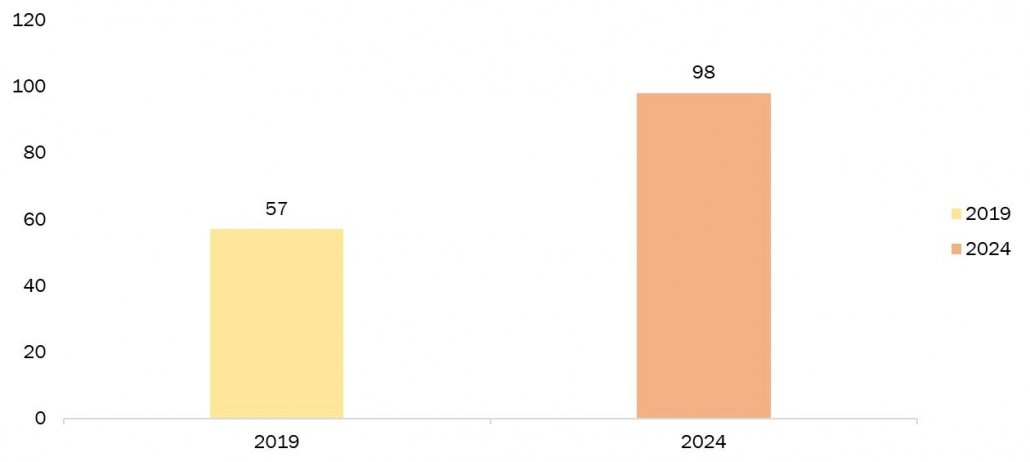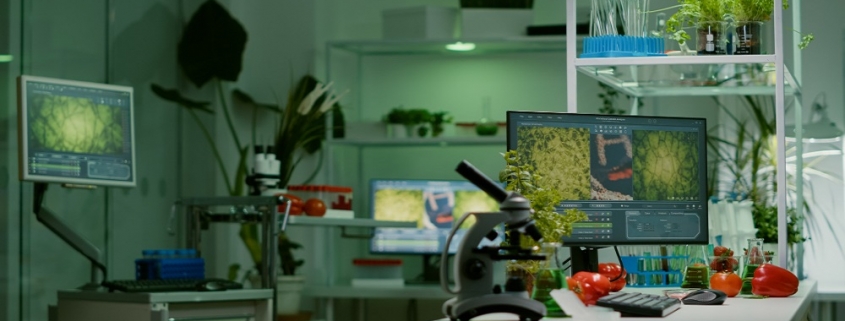Top 10 Emerging Food Technologies in The World
Technology is causing a transformative shift in the food sector, influencing its growth, production, global distribution, and supply chain. Recent advancements in food tech trends are reshaping how the industry manages production, distribution, and consumption, showcasing the impact of technologies like AI and automation. A prominent trend in the food industry is the shift among consumers towards alternative protein sources, including lab-grown food. The pandemic has heightened awareness about nutrition and health, driving an increased demand for nutraceuticals and personalized nutrition. The rise of food e-commerce, spurred by the COVID-19 situation, is another significant trend. Additionally, growing concerns about food safety are influencing food transparency throughout the value chain.
As digitization becomes integral to the food and beverage industry, companies are embracing restaurant digitization, digital food management, and food robotics to enhance operational efficiency. Food brands are actively addressing food waste reduction and adopting zero-waste practices. Notably, 3D food printers are emerging as a key component in the realm of food science and technology, facilitating major trends such as meat alternatives and personalized nutrition.
The top 10 emerging technologies are:
- Ghost Kitchens
- Robotics in Food
- Smart and Sustainable Packaging
- Plant Meat
- Smart Sensors
- Probiotic Drinks
- Forward Osmosis
- Nutraceuticals
- 3D food printers
- Restaurant Digitization
Let’s discuss each one in detail.
1. Ghost Kitchens
Ghost kitchens, also known as virtual kitchens or cloud kitchens, represent a modern and innovative concept in the food service industry. Unlike traditional brick-and-mortar restaurants, ghost kitchens operate solely for online food delivery and takeaway services, eliminating the need for a physical dine-in space. These kitchens focus on efficiently preparing and fulfilling orders placed through various online platforms. The key characteristic of ghost kitchens is their absence of a traditional storefront or customer-facing space. Instead, they leverage technology and digital platforms to reach customers directly. This model enables greater flexibility for chefs and restaurant owners, as they can experiment with diverse menus and culinary concepts without the constraints of a physical location.
Ghost kitchens capitalize on the growing trend of food delivery and the convenience sought by modern consumers. By streamlining operations and reducing overhead costs associated with maintaining a traditional restaurant space, ghost kitchens can offer a wide range of cuisines and dishes at competitive prices. Overall, the ghost kitchen concept embodies the intersection of technology, culinary innovation, and evolving consumer preferences, shaping the future landscape of the food service industry.
The Government of Delhi, in its Cloud Kitchen Policy, released in April 2022, stated that at that time, 20,000 cloud kitchens operated in Delhi, and are growing at a 20% growth rate every year.
2. Robotics in Food
The food industry, a significant sector with high employment rates, faces challenges in maintaining a seamless supply chain and ensuring food safety due to human intervention. To address these issues, industrial automation emerges as a crucial solution. In the present context, automation is indispensable for both food production and distribution. Manufacturers utilize automation and robotics in food production and packaging, leading to extended shelf life, enhanced food safety, and improved production cost efficiency.
Automation incorporates technologies like AI, robotics, and drones. AI-based systems enable manufacturers to efficiently manage food production and delivery processes, enhancing operational efficiency. Through data analysis, food manufacturers can identify items and consumer demands, aligning production with these needs. The integration of robotics and AI software development enables companies to monitor critical operations such as processing, shipping, and storage, resulting in better oversight of food quality and safety. Many food service companies today are making significant investments in robotics and AI to streamline their operations. In a report by the government of the USA in 2020, industrial robot density in the food and beverage industry increased from 0.9 to 3.1 per 1 million hours, from 2003 to 2017.
Increase In Industrial Robot Density In The Food And Beverage Industry, From 2003 To 2017, Per 1 Million Hours

Source: USA Automation Report 2020
In September 2020, Bear Robotics, a U.S.-based startup, developed Servi, an autonomous robot tailored for food service. This robot collaborated with waitstaff to efficiently deliver dishes and beverages in tight spaces. By employing advanced camera and laser sensor navigation, Servi could navigate seamlessly without encountering blind spots.
3. Smart and sustainable packaging
Smart and sustainable food packaging integrates innovative technologies and eco-friendly materials to revolutionize the way we package and consume food. These solutions aim to reduce environmental impact by utilizing recyclable or biodegradable materials, minimizing waste. Additionally, smart packaging incorporates technology like sensors to monitor freshness, temperature, and shelf life, ensuring food safety. By combining intelligence with sustainability, these packaging solutions contribute to a more efficient and environmentally conscious food industry.
Biopolymers are gaining attention due to their environmentally friendly characteristics such as biodegradability, biocompatibility, and bio-based origins. These polymers can be obtained from food waste through extraction or fermentation processes. Polylactic acid (PLA) and polyhydroxyalkanoates (PHA) are two prominent biopolymers widely used in the production of biodegradable plastics. In a report on sustainable packaging by World Food India 2023, the demand for PLA is anticipated to double by 2023, while commercial PHA production reached 2.05 million tons in 2017. The global PHA market is forecasted to increase from USD 57 million in 2019 to USD 98 million by 2024.
Global Pha Market, In Us$ Million, From 2019 To 2024

Source: World Food India Report
4. Plant Meat
Consumers are progressively embracing alternative protein sources, motivated by health and environmental concerns. This emerging trend in food technology encompasses options like cultured meat, lab-grown food, plant-based nutrition, edible insects, and mycoprotein. These alternatives offer significant nutritional value and resource efficiency throughout the production-to-consumption process, presenting a notable departure from conventional livestock-based protein sources.
The Protein Brewery, a startup based in the Netherlands, creates FERMOTEIN, a unique lab-grown food without animal components. FERMOTEIN is produced by fermenting non-allergenic crops and fungi, enriching them with essential amino acids and fibre. With a 10% fat content and strong water-binding properties, this protein alternative delivers a taste resembling meat.
5. Smart Sensors
Smart sensors have simplified food production processes by providing essential insights to production managers. These sensors play a crucial role in tasks such as inventory counting, ingredient examination, temperature maintenance, and overall operational efficiency. In addition, businesses can extend the use of sensors to delivery vehicles, ensuring smooth distribution processes. The agri-food industry is gradually embracing Industry 4.0, with larger enterprises leading the way in adopting the latest technological advancements. However, the majority of agri-food companies in Europe, often SMEs, still lack smart sensor integration in their production setups. Many rely on manual data registration, and data interpretation is typically handled by a limited number of personnel with specific expertise, which may not be systematically documented.
6. Probiotics drinks
Fruits and vegetables are renowned for their abundance in nutrients, antioxidants, vitamins, dietary fiber, minerals, and bioactive molecules, constituting a vital element in a well-rounded diet with proven health benefits. The incorporation of probiotics into plant-based juices for the production of functional and nutraceutical food provides a cholesterol-free and allergen-free alternative to dairy probiotics, catering to individuals with lactose intolerance. This review emphasizes the positive impact of different probiotic strains on various diseases and compares the nutritional aspects of plant-based and dairy probiotic drinks. Market trends in probiotic drinks are discussed, with a comprehensive list of current plant-based probiotic drinks available globally. The fermentability of carbon sources in fruit and vegetable juices by probiotic microorganisms is crucial, and the metabolic pathways involved in sucrose, glucose, fructose, and galactose are highlighted. The review concludes by outlining key quality monitoring factors for probiotic products, including total soluble solids, sugar consumption, titratable acidity, pH, and stability at low storage temperatures.
7. Forward Osmosis
In the realm of food processing plants, the concentration process plays a crucial role in preserving food products until they reach consumers. Australia’s CSIRO organization, in collaboration with a U.S. membrane technology company, has researched to develop an innovative preservation processing technique utilizing membrane technology for liquid concentration, known as “forward osmosis.” Forward osmosis represents a milder approach to concentrating food, requiring less energy and avoiding the use of heat. This method contributes to the natural retention of more nutrients, such as proteins and vitamins, during processing. As a result, the final product exhibits higher quality compared to those produced using traditional concentration methods.
Forward osmosis, a promising desalination technology, has demonstrated significant potential due to its lower energy requirements compared to reverse osmosis. Forward osmosis, also known as FO, can serve as a complementary method for treating brackish water, higher salinity water, and produced waters from oil and gas operations. One notable advantage is its immunity to intrinsic osmotic pressure limitations. Additionally, it exhibits greater tolerance to contaminants that could otherwise foul membranes used in reverse osmosis, especially under high pressures. Water for the food industry is provided either by local government authorities or by the food business itself. In Europe, most of the drinking water supplied to the food industry is sourced from public supplies. However, the origin of the water used for drinking water can vary and may include surface water (such as streams, rivers, and lakes), groundwater (including natural springs and wells), rainwater, and seawater (treated at desalination plants).
8. Nutraceuticals
Growing concerns about the impact of dietary habits on health and increasing demand for essential nutrients to support a healthy lifestyle have become more pronounced, particularly in the context of the COVID-19 pandemic. This heightened awareness among consumers is driving a significant trend in the food industry, placing nutraceuticals at the forefront. Nutraceuticals encompass a range of products, including nutritional supplements, functional foods, medicinal foods, and gut microbiome-enhancing foods like prebiotics, probiotics, and postbiotics. Ongoing scientific research on nutraceuticals highlights their potential health benefits, particularly in addressing disorders associated with oxidative stress, such as allergies, diabetes, and immune-related conditions.
An example of innovation in this space is the US-based FoodTech startup Farmhand Organics, which specializes in crafting hand-made, naturally probiotic, plant-based fermented foods using organic ingredients. The startup’s organic krauts and kimchi are designed to promote healthy digestion, contribute to maintaining balance in sleep and immunity, and offer nutrient-rich and flavourful options. Notably, Farmhand Organics prioritizes sourcing ingredients directly from family farms and local suppliers, contributing to a reduced carbon footprint associated with transportation.
In the year 2021, Brightseed and Ocean Spray joined forces to leverage Brightseed’s A.I., Forager®, to profile the components of cranberries and uncover novel connections between cranberries and human health. Through this collaboration, Ocean Spray aims to establish the most extensive nutritional profile of cranberries globally.
9. 3D Food Printers
3D food printers offer opportunities for customized diets and the development of protein-based meals, providing precision and reliability in nutritional content. While material extrusion remains the predominant method in food printing, startups are exploring innovative techniques such as laser and inkjet food printing, along with bioprinting. These inventive approaches enhance the quality and accuracy of 3D-printed food items. With a focus on meeting specific product requirements and ensuring consistent quality, ongoing research in 3D food printing aims at large-scale food production. Consequently, 3D food printing streamlines production processes and lowers costs. Moreover, it enables food brands to offer personalized food products at scale without the need for additional tooling and operational expenses.
SavorEat, an Israeli startup, specializes in creating plant-based meat. The company utilizes a combination of chef robots, proprietary 3D printing technology, and non-GMO ingredients to produce meat. Currently, SavorEat focuses on manufacturing meatless burgers with plans to diversify its offerings to include steaks, kebabs, and alternative seafood.
10. Restaurant Digitalisation
Based on research conducted by the National Restaurant Association in 2020, the restaurant sector experienced a sales decline exceeding $120 billion, leading to the layoffs or furloughs of 8 million employees by May 2020. Projections suggested that the pandemic might result in losses amounting to $240 billion by the year’s end.
The incorporation of digital technology in restaurants not only enhances customer satisfaction but also optimizes operational processes, resulting in increased efficiency. It enables restaurant brands to gather valuable data at various stages, supporting data-driven decision-making across their operations. The disruptions caused by the COVID-19 pandemic have expedited the implementation of digital management systems across the entire food and beverage supply chain. To reduce direct person-to-person contact, restaurants are incorporating digital menus, self-service kiosks, and cashless payment options.
Find some of our related studies:



